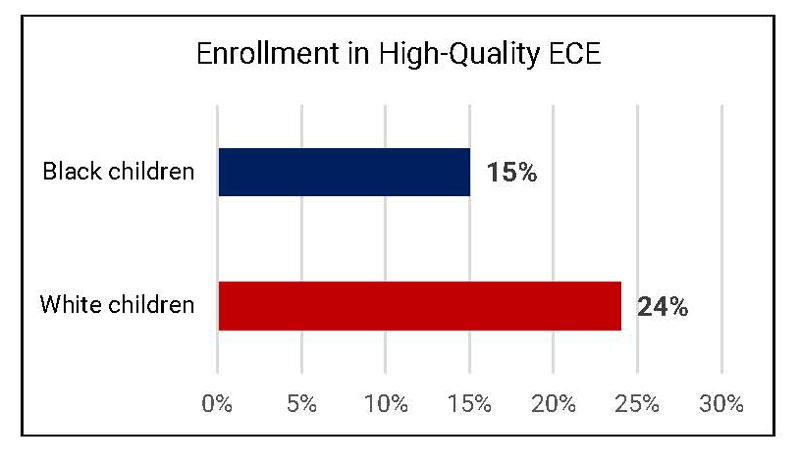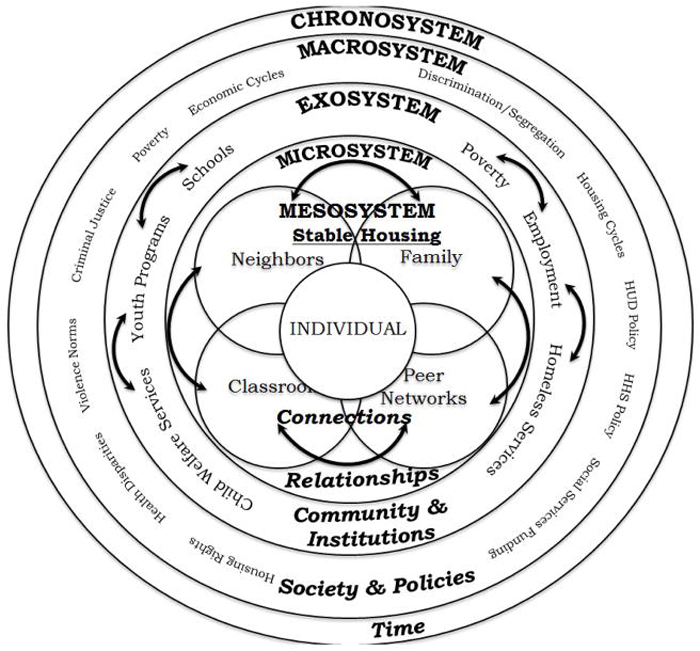Sustaining the Impact of High-Quality Early Childhood Education for Children and Families
Print This Post

More than 6 million young children are enrolled in child care nationwide. More than 80,000 are enrolled in Georgia Pre-K, and there are more than 11,000 early care and learning settings in Georgia, according to the Georgia Department of Early Care and Learning (DECAL).
The reach of these initiatives highlights the importance of early learning programs, high quality care, teachers in these settings, and the role these programs play in child and family development. The average cost of center-based early education in the United States is nearly 30% of the median family come and only 10% of the programs are considered high quality, according to a report titled, “Quality 101: Identifying the Core Components of a High-Quality Early Childhood Program,” by Simon Workman, associate director of Early Childhood Policy, and Rebecca Ullrich, a policy analyst for the Early Childhood Policy team at the Center for American Progress.
Sustaining High-Quality Education
Parents often have few child care options and the number of high-quality options is limited—if available at all. According to Workman and Ullrich, wait lists for child care are often long, and for high-quality care even longer. Families often live in areas where there are no high-quality environments available.
Research has shown that there are significant disparities in access to high-quality care for black and Hispanic children compared to white non-Hispanic children, according to a special report titled, “Access to High-Quality Early Education and Racial Equity,” by Allison Friedman-Krauss and Steven Barnett of the National Institute for Early Education Research. Workman and Ullrich point out that children from homes with higher stress, lower income, less stability, and fewer resources are the least likely to have access to high-quality early education that can help mitigate these factors.

High-quality early childhood education is associated with reduced disparities between low and high-income children’s educational attainment and earnings in adulthood. The more time children spent in high-quality education, the greater the reduction in disparities in college graduation and adult wages.
Research has shown that high-quality early education is linked to improved educational and life outcomes. Impacts are even more significant for children from low-income families, according to an article titled, “Adult outcomes of sustained high-quality early child care and education: Do they vary by family income?,” by Andres Bustamante and Deborah Lowe Vandell of the School of Education, University of California Irvine, and Eric Dearing and Henrik Daae Zachrisson of the Lynch School of Education and Human Development, Boston College. These outcomes can be long-lasting when the systemic structures and supports are in place. Outcomes for children who attended high-quality early childhood education for at least two years were as positive as those for high-income peers in terms of education attainment and adult salaries. Research continues to demonstrate that children who participate in high-quality early education are more likely to demonstrate positive outcomes. They’re:
- more likely to graduate from college,
- less likely to receive government assistance,
- less likely to need special education services,
- less likely to be involved in juvenile offenses,
- more likely to be highly engaged in education over time, and
- experience higher academic performance and achievement over time.
Head Start, Early Head Start, child care, state pre-K programs, and other high-quality publicly funded early education programs are designed for low-income families, but Workman and Ullrich point out that the funding significantly limits access. There’s a waiting list in most counties for these limited seats and programs. In Georgia, only 49% of the eligible children are enrolled in pre-K, down from 60% in 2012, according to The Annie E. Casey Foundation. The limited access to high-quality childhood education programs for low-income families results in 48% of low-income children ready for kindergarten compared to 75% of moderate or high-income children.
Some of the key components to achieve and maintain high levels of quality include core health and safety requirements, such as:
- a professional and stable teacher workforce supported with training and education, as well as professional compensation and benefits;
- effective leadership, which includes instructional leaders who are fluent in developmentally appropriate practice and teaching, sound business management skills, and organizational management and relationship building;
- age-appropriate curriculum that is developmentally, culturally, and linguistically relevant for all children;
- comprehensive family engagement activities that are responsive to family needs, recognize and honor the diversity of families, and engage in an inclusive and reciprocal way understanding cultures and values;
- a multilevel continuous quality improvement system that allows programs to monitor, reflect, and revise policies and practices to ensure that they maintain quality;
- a sustainable and sufficient set of funding mechanisms that ensure that staffing and business decisions can be planned accordingly;
- coordinated transitions between early care and learning settings and the public school system;
- strong and sustained relationships with families that include transition supports to school system; and
- supportive social emotional development that leads to young children who are motivated to learn in school, positive about school and educational experiences, and have greater educational engagement.
Sustaining the Impacts of High-Quality Education
Research also indicates that high-quality early education requires highly resourced programs and experiences. This can be difficult to scale and provide on a regular basis in under-resourced communities. High-quality early education that is community based can have long lasting impacts on children’s long-term success, according to a commentary by Bustamante, Vandell, Dearing, and Zachrisson titled, “High-quality early child care and education: The gift that lasts a life time. Brookings Institute: Education Plus Development.”
Senior Policy Analyst Sonya Acosta of the Center on Budget and Policy wrote in a blog entry titled, “Priorities Stable Housing is Foundational to Children’s Well-Being,” that sustained access for all young children is critical not only within classrooms, but also in community-based warm, safe, and supportive environments that are language rich with hands-on and play-based exploration and learning. These factors can help mitigate challenges related to housing, community stability and safety, and other related factors.
A research report by Arthur Reynolds titled, “The Power of P-3 School Reform,” points out that the combination of access to high-quality early learning environments and continuity through the public school system and community as a whole is critical to sustaining the impacts of high-quality early education on student and family achievement. Communities are key in ensuring that early education impacts are sustained over time.
High-quality early care and education, according to Reynolds, Workman, and Ullrich, depends on teacher and child engagements, developmentally appropriate practices, and curriculum. These factors are critical in both early childhood education settings and in elementary school programs with coordination between them. Key factors in quality include:
- interpersonal interactions: well-trained and skilled teachers, responsive language, engaging with all children, fostering independence, language rich environment, empathetic, respectful, and warmth;
- physical environment: safe for play, exploration, and learning; developmentally appropriate materials, promoting independence and exploration in developmentally appropriate ways; and learning environments; and
- program support structure: high-functioning operating environment, administrative operational support, effective leadership support to instruction and sound business management, administrative support and advocacy for family engagement and positive guidance practices, access to professional development, quality improvement resources, funding streams, and well-trained teachers.
Teacher education, training, and professional development are all critical for young children’s success and development, as well as to sustaining impacts of high-quality programs. Training and teacher preparation, for both early childhood and early elementary education teachers and administrators is critical to ensure that high-quality programs provide academic supports and engagement, social-emotional development, family engagement, and developmentally appropriate practices. This is particularly vital for ensuring that programs focus on developmentally appropriate guidance and disciplinary practices to eliminate the use of suspension, expulsion, soft-expulsion, and disparities in disciplinary actions. Positive and developmentally appropriate guidance and discipline practices are key to ensure that students and families feel positively about school and connected to teachers and peers. Early childhood education experiences set the stage for later school engagement, so positive engagements are critical during this period, according to Zissner and a webinar by The Hunt Institute titled, “The Case Against Preschool Suspension and Expulsion.”
To fully sustain the impact of high-quality education, it’s necessary for children to attend early childhood education for at least two years, and it’s critical to connect high quality early education with P-3 modeling to ensure continuity into elementary school to eliminate the achievement gap, according to Reynolds and Federal Reserve Bank of Minneapolis report titled, “Sustaining Early Childhood Education Gains,” by economist Rob Gruneman. This includes focusing on and developing collaborative leadership, aligned curricula, continuity and stability for children, effective learning experiences through small classes, professional development for teachers, and parent involvement and engagement. Professional development opportunities and resources must also be coordinated and supported between early education and public school programs to ensure comprehensive understanding of developmentally appropriate practices and curriculum as well as the additional supports and resources needed for individual children.
Parent involvement, according to Gruneman, also is a critical component of sustaining the impacts of high-quality early childhood education settings. Research indicates that there may be a reciprocal impact on families where families and parents can impact and help sustain the impact for the child while the programs can help improve the environment and stability in the homes. According to Reynolds, ensuring that parents can fully engage in the education system at all levels ensures continuity of education, care, and inclusion of culturally and socially appropriate resources and supports.
Jill Anderson of the Harvard Graduate School of Education to a Harvard points out in an EdCast titled, “The Power of Out-of-School Learning,” that in addition to building consistency between early childhood education and elementary programs, it’s vital to also build out of school learning opportunities to support early education systems, families, and school programs. These experiences allow young people to explore what they enjoy, build social relationships, and develop additional relationships with young adults. These experiences can include Boys & Girls Clubs, YMCA programs, camps, faith-based programs, libraries, and other after school programs. Teachers and providers who are well-trained, empathetic, caring, and able to build relationships with young people are a key component in the quality and continuity of care for sustaining the impacts of quality of care over time.
Recommendations for Communities
These are recommendations for communities to facilitate establishing and sustaining high-quality child care:
- Educate community members and families about how to recognize high-quality early care and education and why it matters.
- Provide resources and supports to existing early childhood education settings to help address challenges and improve quality of care, which includes professional development for teachers and classroom resources.
- Advocate for resources for parents to help pay for high-quality early childhood education.
- Provide support and linkages to connect families and caregivers to early childhood education financial subsidies.
- Provide or support efforts to provide professional development and education on topics and areas related to high-quality early care and learning environments.
- Create opportunities for engagement between the early education system and public school system for teachers, parents, and children to ensure more seamless transitions.
- Support communication between early childhood education leadership and elementary school teachers and leadership.
- Continue to improve teacher education and professional development opportunities to include developmentally appropriate practices, cultural awareness and inclusion, collaboration, family engagement, and trauma-informed care.
- Encourage and support communities in advocating for systems and policy changes that increase care options, supporting families and education providers, and understanding the importance of holistic early education.
- Support efforts to increase the diversity of teachers and administrators in early care and learning throughout the community.
- Advocate for quality rating systems and program improvement efforts that are improvement-based rather than penalty-based.
- Increase linkages between other support programs and early childhood education programs to support stability of environments for young children.
- Build cross-system collaboration for family and teacher support to connect teachers, families, and supports that include mental health, behavioral health, housing, child care subsidies, and food stamps.
- Increase training opportunities and resources on working with young children with adverse childhood events (ACEs) and behavioral challenges and supporting families with trauma.
- Develop specialized support for administrators and educators to address classroom management, resources, and supports in implementing positive behavioral interventions.
Contact:
Bill Valladares
GaFCP Communications Director
404-739-0043
william@gafcp.org
Reg Griffin
DECAL Communications Director
404-656-0239
reg.griffin@decal.ga.gov
Follow us on Twitter: @gafcpnews
Connect with us on Facebook.
Bright from the Start: Georgia Department of Early Care and Learning (DECAL) is responsible for meeting the child care and early education needs of Georgia’s children and their families. It administers the nationally recognized Georgia’s Pre-K Program, licenses child care centers and home-based child care, administers Georgia’s Childcare and Parent Services (CAPS) program, federal nutrition programs, and manages Quality Rated, Georgia’s community powered child care rating system.
The department also houses the Head Start State Collaboration Office, distributes federal funding to enhance the quality and availability of child care, and collaborates with Georgia child care resource and referral agencies and organizations throughout the state to enhance early care and education.

